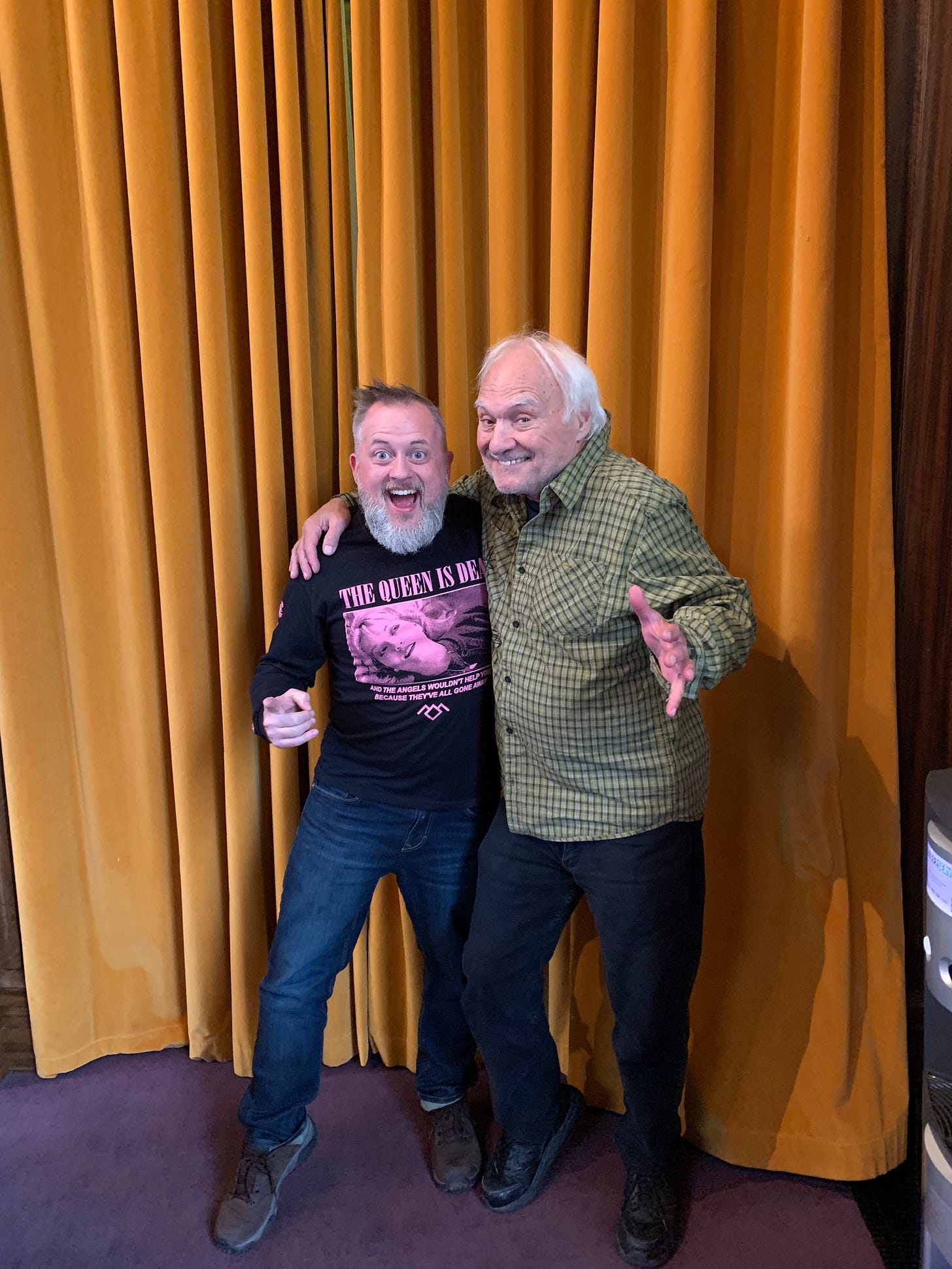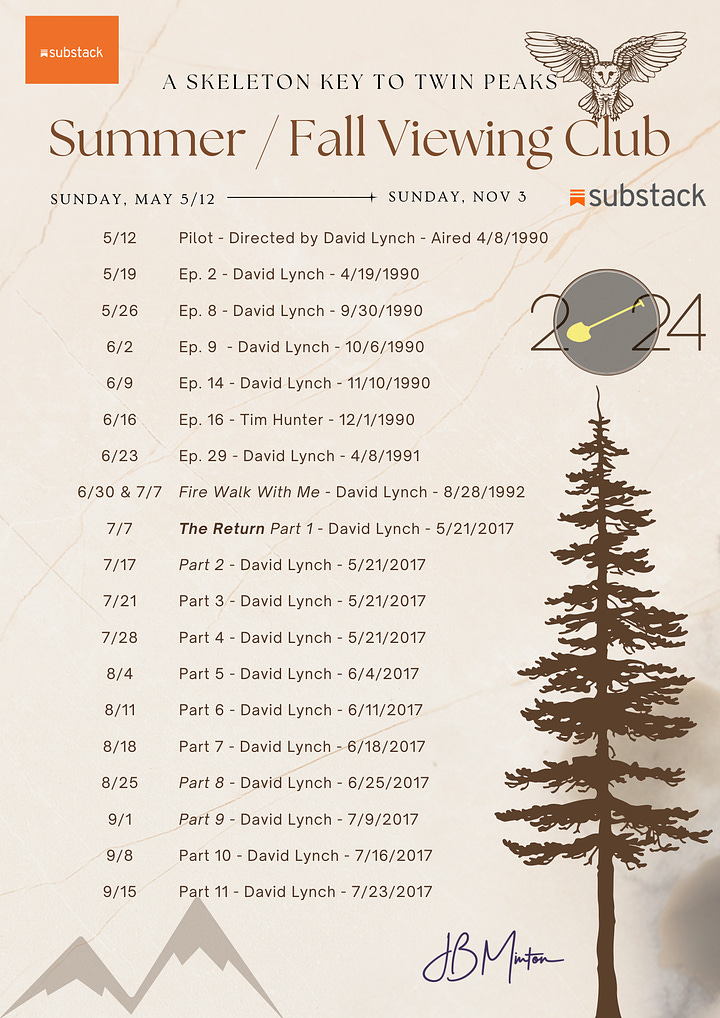
Before You Watch
A new character named Windom Earle, formerly Cooper’s boss, was likely corrupted by Bob and seeks to take a sacrifice (Cooper’s quasi-girlfriend, former Nun, Annie) into a physical version of The Black Lodge. Cooper is going to chase in there after him.
Windom Earle is a demented and hilarious character worth revisiting after this Twin Peaks course of study has concluded.
Before this episode begins, Windom Earle kidnaps Cooper’s girlfriend, then dresses like the Log Lady and steals Pete Martell’s truck. Pete’s pretty pissed off about that.
Pay attention to the singer's song when Cooper enters the Red Room. Sycamore Trees is an anthem for imprisonment, a beautiful and sad song outside this scene's context. The song is a haunting and frightening ode to the death of choice in this scene. The music is a lament for the unceasing battle against all that is good and moral in this universe. Sycamore Trees is a funeral dirge and a heralding of corruption in the seat of the soul.
Here is a link to John Thorne’s book, where I quote from below.
After You Watch
Pay Attention to the Mood Shifts
It starts with love and commitment, then moves into mystery and danger. Comes back to commitment and ends with a cruel revocation of choice.
There’s a King Arthur Thing
Cooper sees himself as a chivalrous protector. He is, but he’s also harmed people. He broke up a marriage between Windom and Caroline (backstory). He’s not perfect, and his death could be the weakness of compensating by always taking action to save the damsel in distress.
This will not be the last time King Arthurian symbols pop up.
From the start of the series, Dale Cooper shined brightly as a singular creation. He was a radiant, utterly unique individual who subverted the norms of the traditional fictional detective. More than a mere FBI agent, Cooper was that rare type of character whose complex, sometimes contradictory characteristics elevated him beyond the trappings of the narrative. Cooper by himself was fascinating…an autonomous being, a rounded character who could not be summed up with conventional labels such as “detective” or “crime-fighter.” (234)
John Thorne, The Essential Wrapped In Plastic, Half The Man He Used To Be: Dale Cooper In The Red Room, 2016
Nadine’s Dilemma
Nadine was asleep and happy in life. Now she is awake, and everyone is miserable. The masks we put on in dreams and alternate layers of reality often surprise us by revealing what we need and how often we work against that purpose.
Cooper is about to sleep for a long time in his mind. It was a deep sleep that untethers him from the foundation of his self. Cooper will dangle from an imaginary string at the edge of transcendence, stretching until it breaks. And that string will break. Prepare for it now.
Dell Mibbler and The Metaphor of a Bank Explosion
The bank explosion can be a metaphor for what is happening in Cooper’s mind. I will argue that the nuclear explosion in Part 8 of Twin Peaks: The Return also serves as a metaphor for the parasitic invasion of a force of malevolence and the danger of a soul’s corruption.
Sarah Palmer Is Going Through Some Things
Sarah Palmer is a vessel of suffering. On paper, she’s lost her husband and her daughter and is aware of the incestual rape she allowed to take place under her roof. On paper, Sarah Palmer should suffer. She was a terrible mother. It would have only been worse if she participated in the violent sexual abuse and murder of her child.
In this scene, she channels someone beyond the narrative world of the RR Diner, someone from where Cooper is now trapped. This entity speaks through Sarah Palmer to warn Major Briggs that he is being tapped to join the Cooper recovery team. This will impact what we see happen in The Return.
“When You See Me Again, It Won’t Be Me”
There is so much to say about this statement, but I will simplify it and say that it is the greatest understatement of Twin Peaks. After years of studying this art, I am convinced that nearly all of what happens from this point forward is taking place inside Cooper’s mind as he struggles under his soul’s corruption with periodic flashes of scenes from the “real world” of Twin Peaks that are relevant only because they metaphorically convey the emotional disintegration of Cooper’s memories and dreams to expose his incorruptible nature.
Meanwhile…A Waiting Room Is A Place Where The Living Wait
Laura Palmer’s finger snap is the closing of a jail cell. Cooper is about to enter what I have come to call The Cooper Loop, a cyclical repetition of him mentally going through Laura Palmer’s case file. Instead of being a prequel, I believe that Fire Walk With Me is a sequel and represents Cooper going through Laura Palmer’s story, what he knows, what he suspects, what he makes up, and what is inserted by malevolent forces looking to suppress his soul and possess his mind by allying with all that is evil inside him.
Yet, as this episode establishes, the Red Room is also a physical place.
Up until now access to the Red Room had been solely through dreams, underscoring the Red Room’s nature as a reflection of the subconscious But in the final episode Cooper was physically entering the Red Room. (236)
The Red Room(s) may be another plane of existence—a palpable, otherwordly dimension—but it is also a province of the mind. As such, it takes on distinct characteristics for each visitor. (239)
John Thorne, The Essential Wrapped In Plastic, Half The Man He Used To Be: Dale Cooper In The Red Room, 2016
One And The Same…About These Divas, Devils and Dopplengangers
I have come to think of the Red Room as a purgatorial psychic estuary where the mental projections of sad souls become ensnared and tortured by creatures who consume human suffering in the form of what looks like creamed corn. And heroes don’t survive long in this place.
These half-souls haunt Cooper on his passage deeper into the Red Room, reminding him of his failure to prevent their deaths and, of course, alerting him to the real possibility of psychological division. (239)
John Thorne, The Essential Wrapped In Plastic, Half The Man He Used To Be: Dale Cooper In The Red Room, 2016
To All The Women Cooper Failed Before...
Heroes fall in the Red Room because they are flawed characters, filled with good intentions, negative energy, and pressure coming at them from all sides, armed with shame and anger. Whatever keeps these souls suffering keeps these creatures fed.
Suppression And Retreat Expose The Soul To Corruption
When Cooper flees and turns back, his journey twists, and the exit disappears. Reacting in fear is the path to the dark side, whether comparing Lord of the Rings, Rocky, Iron Man, Star Wars, He-Man, Dune, or Twin Peaks. Fear is the mind-killer.
But There Are Rules To The Soul’s Corruption
Spiritual safeguards operate in the universe and mythology of Twin Peaks. These safeguards serve to protect the individual’s soul from complete corruption. A person seems limited in their capture to 25 years of dream time. During this dream time, much suffering can be milked by dipping the imagination in fear. There is a process to eject the dark half from the dream after some time passes. This should strip Bob of power when aligned with a host’s dark side.
But Bob is a wily creature. He has discovered how to manipulate and break the system. He broke Leland and allied with Leland’s dark side; they did horrible acts together for many years. Laura was supposed to be next, but she may have sacrificed herself. And what does it matter to Cooper’s soul if Laura did make that sacrifice? He still ends up soul-corrupted. I believe that Bob will execute a new plan that could break this entire system and unleash evil at a scale that could destroy the universe or perhaps only annihilate Cooper’s soul.
Bob functions both as a tangible antagonist and as a metaphor for an indvidual’s evil side, his dark impulses. (239)
Earle seems capable of taking a soul and makes an attempt, but his action is immediately negated since “Cooper” no longer has a complete soul to give. (243)
The good Cooper does not confront Bob. He has no reason to. “Cooper” has no fear for Bob now. As for Bob, he knows that Cooper has divided into good and bad. He knows that Cooper is already defeated. (244)
John Thorne, The Essential Wrapped In Plastic, Half The Man He Used To Be: Dale Cooper In The Red Room, 2016
Meet Mr. C
This is Cooper’s double. He is morally split, and the good half doesn’t run fast enough. In the end, the story of Twin Peaks is a race to the exit of a multi-layered dream where one of the runners forgets they are running.
…the [final] sequence was designed to pit Cooper against himself, how Cooper’s fears and self-doubts were manifested in the Red Room, and how these fears and doubts upset the psychological balance between the “good” and “bad” aspects of Cooper’s personality, resulting in a physical division of Cooper into two separate entities. (237)
Although it appears the bad Cooper is chasing the good Cooper, he is in fact racing the good Cooper to the exit. (244)
John Thorne, The Essential Wrapped In Plastic, Half The Man He Used To Be: Dale Cooper In The Red Room, 2016
“I Wasn’t Sleeping.”
Mr. C is now active in this narrative. We are led to believe that he is allied with Bob and directing Cooper’s behavior in the “real world,” meaning the narrative we have been familiar with until now. The viewer will be forced to shift between Cooper-related scenes and scenes in which Cooper is absent. Still, this may be projected through his consciousness as he moves through time and memory. At the same time, he possibly holds vigil over the passing scenes before him as his dreaming mind sleeps through the sickness of Bob’s invasion and alliance with Cooper’s shadow.
[Cooper] is about to embark upon a journey that will lead him back and forth between similar red rooms—rooms that will symbolize the dual halves of his mind. His movement back and forth will signify the oscillating condition of his psyche as his good and bad sides start to seesaw out of control. (239)
It is Cooper’s own fear and uncertainty that lead to his downfall. No outside force can be blamed. In the unstable realm of the Red Room where “anything can happen” Cooper fails to master his own weaknesses. This failure makes Cooper susceptible to the dangerous and darker aspects of subconscious. He pays a profound price—the imbalance in his psyche results in his division into two physical beings. (241)
It is immoral to place blame entirely on the concept of demonic possession. Whether Bob truly exists or not, Leland is ultimately responsible for allowing Bob to gain control…the darker side of Leland was strong, but his good side allowed that side to take over. (244)
In the end the good Cooper fails. The bad Cooper overtakes him and leaves the Red Room…He doesn’t care about Annie and finds it funny that anyone would think he does…Bob, staring from the mirror, is not in possession of Cooper, he is allied with him…Bob is with the bad Cooper. They are essentially in league. (245)
Cooper, who was once complex and rich, has been distilled into components of “good” and “bad.” Whole, Cooper was more than the sum of his parts. Divided, he becomes a lost soul. It is a bitter ending…Sadly, the series ends with the worst of two possibilities—the bad Cooper triumphant. (246)
John Thorne, The Essential Wrapped In Plastic, Half The Man He Used To Be: Dale Cooper In The Red Room, 2016
Next class…Fire Walk With Me. And get ready! You are never safe from this film, even if you've seen it!

















[Podcast] Week 6: 'Twin Peaks Movie Club on Substack